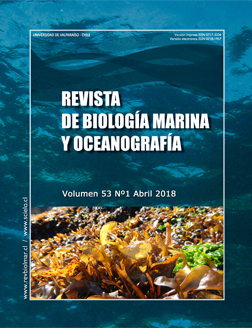Sustainability fishery indicator for Gulf corvina <i>Cynoscion othonopterus</i> in the Upper Gulf of California
DOI:
https://doi.org/10.4067/S0718-19572018000100119Keywords:
Sustainability indicators, Cynoscion othonopterus, Mega-spawners, Optimum length, Upper Gulf of CaliforniaAbstract
The Upper Gulf of California and Colorado River Delta is a zone which is immersed in an ecological, economic, political and social conflict. That is because of the Totoaba Totoaba macdonaldi illegal fishing and the Vaquita Phocoena sinus potential extinction. This issue has driven to ban all the region's fisheries with the exception of the Gulf corvina Cynoscion othonopterus which is the only of the finfish species with operating license. Therefore, the main objetive was to evaluate the fishery's health condition through the Froese sustainability indicators in Upper Gulf of California during 2008, 2013, 2014 and 2015 fishing seasons. The results showed that the Gulf corvina annual production ratio showed fluctuations, highlighting in the 2012-2016 period, when the whole fishing captures with the exception of 2014, surpassed the established quota by the National Institute of Fishery (Instituto Nacional de Pesca). The size-at-maturity were: 2008= L50: 502 mm (IC= 490-514 mm), 2013= L50: 559 mm (IC= 544-576 mm), 2014= L50: 499 mm (IC= 476-518 mm), and 2015= L50: 480 mm (IC= 445-510 mm). Based on the sustainability indicators, it is demonstrated that the Gulf corvina fishery is directed towards the organisms of greater length (mega-spawners). Finally it is concluded that Gulf corvina currently shows problems of over-exploitation and therefore its exploitation is not sustainable. This suggests the need to make adjustments and updates to current management measures.
Downloads
Downloads
Published
How to Cite
Issue
Section
License
Copyright (c) 2019 Universidad de Valparaíso, Chile

This work is licensed under a Creative Commons Attribution-NonCommercial 4.0 International License.
• Los autores que publican en la RBMO transfieren sus derechos de publicación a la Universidad de Valparaíso, conservando los derechos de propiedad intelectual para difundir ampliamente el artículo y la revista en cualquier formato.
• La RBMO autoriza el uso de figuras, tablas y extractos breves de su colección de manuscritos, en trabajos científicos y educacionales, siempre que se incluya la fuente de información.





